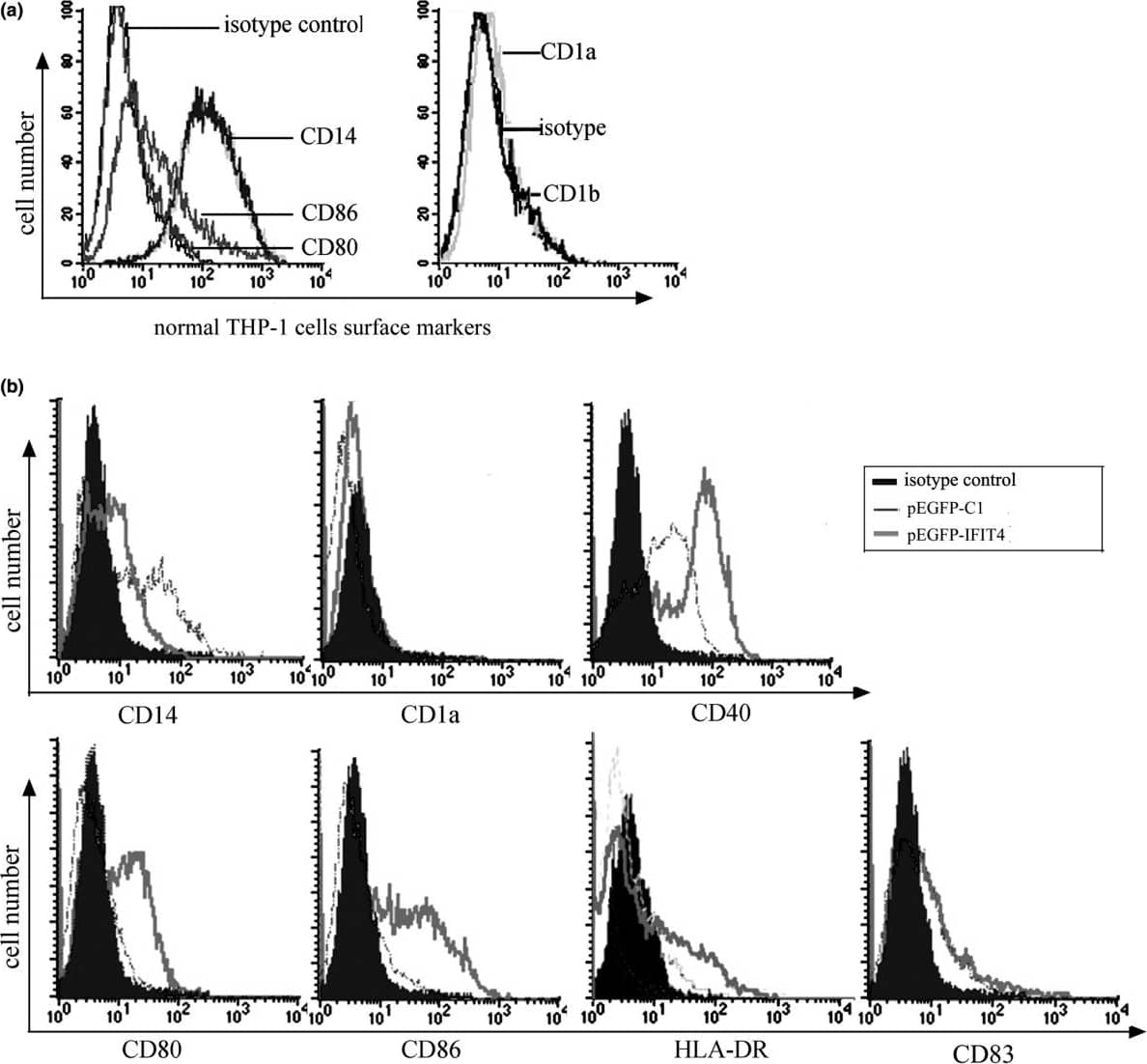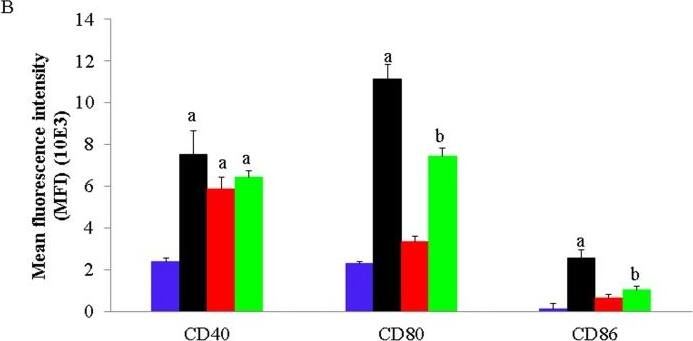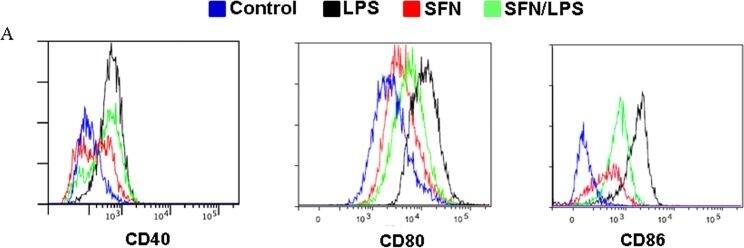Human B7-1/CD80 PE-conjugated Antibody
R&D Systems, part of Bio-Techne | Catalog # FAB140P


Conjugate
Catalog #
Key Product Details
Validated by
Biological Validation
Species Reactivity
Validated:
Human
Cited:
Human, Porcine
Applications
Validated:
Flow Cytometry
Cited:
Flow Cytometry
Label
Phycoerythrin (Excitation = 488 nm, Emission = 565-605 nm)
Antibody Source
Monoclonal Mouse IgG1 Clone # 37711
Product Specifications
Immunogen
S. frugiperda insect ovarian cell line Sf 21-derived recombinant human B7‑1/CD80
Val35-Asn242 (predicted)
Accession # P33681
Val35-Asn242 (predicted)
Accession # P33681
Specificity
Detects human B7‑1/CD80 in ELISAs. In sandwich immunoassays, no cross-reactivity or interference with recombinant human (rh) B7-2, recombinant mouse (rm) B7-1, rmB7-2, rhB7-H1, rhB7-H2, rhB7-H3 or rmPD-L2 is observed.
Clonality
Monoclonal
Host
Mouse
Isotype
IgG1
Scientific Data Images for Human B7-1/CD80 PE-conjugated Antibody
Detection of B7-1/CD80 in Raji Human Burkitt's Cell Line by Flow Cytometry.
Raji human Burkitt's lymphoma cell line was stained with Mouse Anti-Human B7-1/CD80 PE-conjugated Monoclonal Antibody (Catalog # FAB140P, filled histogram) or isotype control antibody (Catalog # IC002P, open histogram). View our protocol for Staining Membrane-associated Proteins.Detection of Human B7-1/CD80 by Flow Cytometry
Comparison of the phenotypic profiles of DCLCs primed with or without IFIT4 over-expression. (a) Surface antigens of normal THP-1 cells were examined by flow cytometry. (b) To analyze the effect of IFIT4 on phenotypic changes of dendritic cell-like cells (DCLCs) during the process of differentiation, THP-1 cells were transfected with pEGFP-IFIT4 or pEGFP-C1; 36 hours later, cells were stimulated with granulocyte-macrophage colony-stimulating factor (GM-CSF; 50 ng/ml) and IL-4 (20 ng/ml) for 90 hours to generate DCLCs. These DCLCs primed with pEGFP-IFIT4 or pEGFP-C1 transfection were incubated with fluorochrome-conjugated monoclonal antibodies (mAbs) and the antigens of CD40, CD80, CD86, CD83, HLA-DR, CD14 and CD1a on the surface of those DCLCs were analyzed by flow cytometry. Appropriate fluorochrome or isotype control mAbs of each antibody species were used as negative controls. Shaded histograms represent isotype control antibodies. The thick line represents DCLCs primed with pEGFP-IFIT4 transfection, whereas the slender lines represent DCLCs primed with pEGFP-C1 transfection. All experiments were performed three times and a set of representative histograms was presented. IFIT4, interferon-induced protein with tetratricopeptide repeats 4. Image collected and cropped by CiteAb from the following publication (https://pubmed.ncbi.nlm.nih.gov/18706081), licensed under a CC-BY license. Not internally tested by R&D Systems.Detection of Porcine B7-1/CD80 by Flow Cytometry
SFN inhibits LPS induced moDC maturation and enhances the phagocytic activity.moDCs at day 7 in culture were used for cell phagocytosis and cell differentiation status analysis. moDCs were pre-incubated for 1 h with or without SFN (10 μM) before stimulation for 24 h LPS (1.0 μg/ml) or to the indicated concentrations. CD40, CD80, and CD86 cellular surface markers expression were analyzed by flow cytometry (A). The flow cytometry results shown were from one experiment of two independent experiments. CD40, CD80 and CD86 mean fluorescence intensity (MFI) determined by flow cytometry (B). The flow cytometry results were combined from two independent experiments and each experiment was performed from triplications. Data are mean ± standard deviations (SD) (the letters a and b P<0.01). The phagocytic activity of moDCs was examined after stimulating with different concentration of LPS (0,5 μg/ml, 1,0 μg/ml, and 2,0 μg/ml) with or without 24 h pre-treatment with SFN (C). The mRNA expression of DCs surface markers CD40, CD80 and CD86 were quantified using qRT-PCR (D). The mRNA expression and phagocytosis results were combined from three independent experiments and each experiment was performed in four replications. The data represented as the mean ± standard deviations (SD) (* P < 0.05; ** P < 0.01; *** P < 0.001). Image collected and cropped by CiteAb from the following publication (https://pubmed.ncbi.nlm.nih.gov/25793534), licensed under a CC-BY license. Not internally tested by R&D Systems.Applications for Human B7-1/CD80 PE-conjugated Antibody
Application
Recommended Usage
Flow Cytometry
10 µL/106 cells
Sample: Raji human Burkitt's lymphoma cell line
Sample: Raji human Burkitt's lymphoma cell line
Reviewed Applications
Read 1 review rated 3 using FAB140P in the following applications:
Formulation, Preparation, and Storage
Purification
Protein A or G purified from hybridoma culture supernatant
Formulation
Supplied in a saline solution containing BSA and Sodium Azide.
Shipping
The product is shipped with polar packs. Upon receipt, store it immediately at the temperature recommended below.
Stability & Storage
Protect from light. Do not freeze.
- 12 months from date of receipt, 2 to 8 °C as supplied.
Background: B7-1/CD80
References
- Azuma, M. et al. (1993) Nature 366:76.
- Freeman, G.J. et al. (1993) Science 262:909.
- Freeman, G. et al. (1991) J. Exp. Med. 174:625.
- Selvakumar, A. et al. (1993) Immunogenetics 38:292.
- Chen, C. et al. (1994) J. Immunol. 152:4929.
- Freeman, G.J. et al. (1993) J. Exp. Med. 178:2185.
Alternate Names
B71, CD80
Gene Symbol
CD80
UniProt
Additional B7-1/CD80 Products
Product Documents for Human B7-1/CD80 PE-conjugated Antibody
Product Specific Notices for Human B7-1/CD80 PE-conjugated Antibody
For research use only
